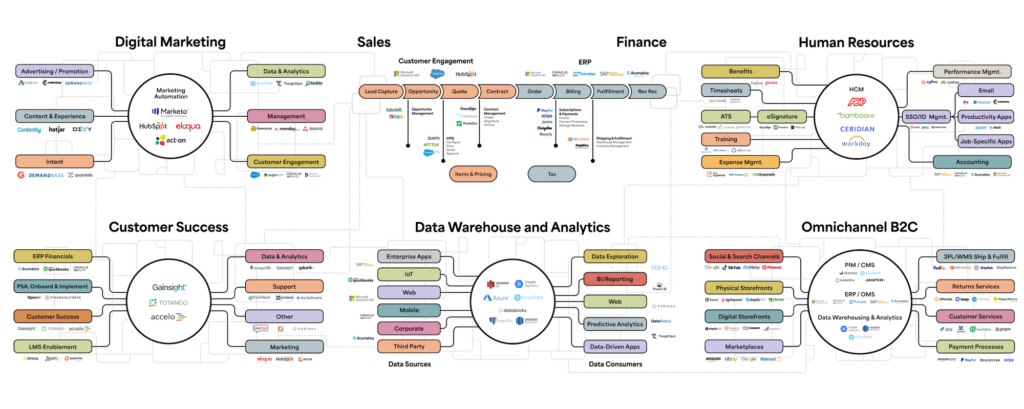Published Apr 24, 2024
Build resilient operations with scalable integration

- Scalability is a key consideration when choosing an integration solution.
- Without scalability, you risk data integrity issues and IT bottlenecks.
- An advanced iPaaS solution offers the greatest scalability and agility.
Whether your company is currently experiencing rapid growth or you’re preparing for the future, connecting your tech stack is the key to building and maintaining resilient operations. Scalable integration is the backbone of high growth, modern businesses. It allows you to quickly adopt innovative new solutions and adapt to shifting markets.
Unfortunately, integrating your tech stack can be more complicated than it seems. SaaS usage continues to grow, with organizations averaging 130 applications, and you will most likely need to connect dozens of systems than span multiple departments. On top of that, as you grow, so will the number of systems you use.
The right solution will simplify this process and give you the scalability you need to succeed at all stages of your business. Let’s explore the benefits of scalable integration, important factors for choosing a solution, and the different integration options available.
The benefits of scalable integration
As your tech stack expands, it will become increasingly difficult to manage, leading to data silos and inefficiencies. By building a solid foundation for scalable integration, you can handle large data volumes with ease–ensuring you have the information you need to make better business decisions.
Integrating your systems will also help you boost the ROI of your SaaS applications, and accelerate automation. You can sync data across numerous systems to eliminate tedious manual tasks–saving you time and resources. This will also help you avoid buying unnecessary subscriptions just for data access.
Here are some other advantages you could see by integrating your tech stack:
- Streamlined operations
- Improved collaboration
- Increased productivity
- Lowered costs
Getting started
Before you implement an integration solution, you should first consider the scope of your project and the resources you have available. Your integration objectives may seem simple, but they can quickly balloon out of control without the proper constraints.

Explore the integrations required to connect all your systems across teams.
For the best results, implement a phased approach. This will allow you to build a foundation and add to it as more systems are integrated. When creating your plan, be sure to look to the future of your business and note any new systems likely to be adopted.
Resources to build and manage your integrations are also crucial to your success, and some solutions require greater resources than others. Whether you rely on internal developers, outsource your integration tasks, or leverage your business team to help build integrations, you should account for the time and money needed to support your goals.
The importance of scalability
While determining the scope and resources available to support your integration efforts, you also need to pinpoint the business processes that are most critical to your ability to scale and the applications that support them. These are the applications you should tackle integrating first.
As you automate more processes, more teams and their business applications need to be integrated. This makes scalability a critical component of choosing an integration solution.
If you don’t choose a scalable solution, you could face a variety of challenges as you grow including:
- Data integrity issues
- Increased error management tasks
- Compliance and security risks
- IT bottlenecks
Evaluating your options
Numerous integration solutions exist to assist you in achieving your desired outcomes, but not all are equipped to support a growing business. To find a solution that will be the best fit for your organization, explore these common solutions.
Coded point-to-point integrations
Skilled developers can write code to integrate APIs. These integrations can be performed by internal employees or outsourced to external resources. This approach is common for organizations with development teams who have the bandwidth to implement, manage, and maintain integrations. While this solution allows developers to meet any custom requirement, it also tends to be expensive and time-consuming.
Dive deeper into the capabilities and limitations of coded point-to-point integrations with our blog, “Choosing the right path: iPaaS vs. coded point-to-point integration.”
Vendor-provided integrations
Many SaaS applications offer point-to-point integrations to popular hub applications like Salesforce or NetSuite to address common use cases. These integrations can be completed by business system administrators to exchange data between two applications. This solution is a good fit for simple integration scenarios with a limited number of application endpoints and integration flows.
Discover how vendor-provided integrations compare to advanced iPaaS solutions in our blog, “Vendor-provided integration vs. iPaaS: Unpacking the pros and cons.”
Workflow automation
Workflow automation tools are designed to streamline and automate specific tasks and processes. These tools allow users to create automated workflows by connecting different applications and services. This solution is best for simplifying repetitive tasks, reducing manual intervention, and ensuring a smooth sequence of actions. This is an excellent solution for task-based use cases but is difficult to manage at scale.
Explore the nuances of workflow automation platforms with our blog, “Mastering integration: Comparing workflow automation platforms vs. iPaaS.”
Traditional iPaaS
Traditional iPaaS (Integration Platform as a Service) solutions enable IT organizations to accelerate integration and business process automation. This solution provides developers with a suite of cloud services, enabling more efficient development, execution, and governance of integration flows.
Learn more about the differences between traditional and advanced iPaaS solutions in our blog, “The future of integration: Comparing traditional and advanced iPaaS.”
Advanced iPaaS
An advanced iPaaS solution goes beyond the traditional iPaaS by enabling business users to build, deploy, and manage their own integrations. With this solution, IT is no longer a bottleneck and every member of the organization can contribute to automation efforts.
This solution is also ideal for scalability. With no practical limit to the number of applications, flows, or size of data, this solution is ready to grow with you.
Future-proof your business with an advanced iPaaS
An advanced iPaaS like Celigo is built with scalability and flexibility in mind. With your business teams empowered to build and manage their own integrations, your IT team can focus on driving strategic initiatives forward. You’ll be ready to quickly adopt the latest innovative solutions and rapidly act as the market shifts.
Ready to see how an iPaaS can help your business integrate your entire tech stack? Contact us today.



